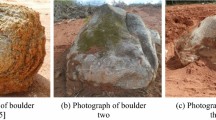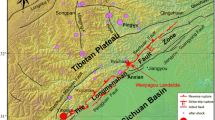Abstract
This paper aims to assess the instability hazard of a granite boulder. The procedure was first to consider the geological setting and geomorphologic features of the boulder in relation to typical granite landscape forms. Climatic and seismic data were next obtained from different sources, and geomechanical parameters were measured in situ and in the laboratory, with terrestrial laser scanning techniques used to measure shape and volume and to conduct a detailed survey of the boulder. Different analytical approaches were then applied to the calculation of boulder safety factors against sliding and toppling. Since the boulder was considered to be unstable in the worst possible scenario, a particle code approach was used to determine its fall trajectory, calculate the final run out of the block, and assess the risk for houses located at the foot of the slope. Finally, conclusions were drawn regarding the instability hazard, and recommendations were made in regard to definitively stabilizing the granite boulder.













Similar content being viewed by others
References
Agliardi F, Crosta GB (2003) High-resolution three-dimensional numerical modeling of rockfalls. Int J Rock Mech Min Sci 40:455–471
Alejano, LR (2006) Una metodología empírica para estimar las propiedades resistentes de los jabres o granitos alterados. Ingeniería del Terreno. (An empirical method to estimate the strength characteristics of highly and completely decomposed granites). Ingeo Ter 8. pp 39–64, U.D. Proyectos, E.T.S.I. Minas-U.P.M. Madrid
Alejano LR, Alonso E (2005) Application of the shear and tensile strength reduction technique to obtain factor of safety of toppling and footwall rock slopes. Proceedings of the ISRM Conference on Rock Mechanics. EUROCK 2005. Brno, Tzchec Republic. Edit Konecky. Taylord & Francis
Alejano LR, Gómez Márquez I, Pons B, Bastante FG, Alonso E (2006) Stability analysis of a potentially toppling over-tilted slope in granite. 4th Asian Rock Mechanics Symposium. Singapur, pp 8–12
Alejano LR, Pons B, Bastante FG, Alonso E, Stockhausen H (2007) Rockfall control in quarrying by means of slope geometry design. Int J Rock Mech Min Sci 44:903–921
Alejano LR, Stockhausen H, Bastante FG, Alonso E, Ramírez-Oyanguren P (2008) ROFRAQ: an empirical method to estimate the risk of accidents due to rockfalls in quarries. Int J Rock Mech Min Sci 45:1252–1272
Ayala-Carcedo FJ, Cubillo-Nielsen S, Álvarez A, Dominguez MJ, Laín L, Laín R, Ortiz G (2003) Large-scale rockfall reach susceptibility maps in La Cabrera Sierra (Madrid) performed with GIS and dynamic analysis at 1:5,000. Nat Haz 30:325–340
Aydin A (2006) Stability of saprolitic slopes: nature and role of field scales heterogeneities. Nat Haz Earth Syst Sci 6:89–96
Azzoni A, de Freitas MH (1995) Prediction of rockfall trajectories with the aid of in situ test. Rock Mech Rock Eng 28(2):111–124
Badger TC, Lowell S (1992) Rockfall control Washington State. In: Rockfall prediction and control and landslide case histories. Transportation Research Record, Natural Research Council, Washington, No. 1342, pp 14–19
Barton N (1973) Review of a new shear strength criterion for rock joints. Eng Geol 7:287–332
Barton N (1976) The shear strength of rock and rock joints. Int J Rock Mech Min Sci Geomech Abstr 13:255–279
Barton N, Bandis S (1990) Review of predictive capabilities of JRC-JCS model in engineering practice. Proc Int Soc Rock Mech Symp rock joints. Loen (Norway). pp 603–610
Barton N, Choubey V (1977) The shear strength of rock joints in theory and practice. Rock Mech 10:1–54
BOE (Spanish Official State Bulletin) (2002) REAL DECRETO 997/2002, de 27 de septiembre, por el que se aprueba la norma de construcción sismorresistente (Spanish standard for seismic protection)
Brown ET (ed) (1981) Rock characterization, testing and monitoring. Pergamon Press, New York 211 pp
Bunce CM (1994) Risk analysis for rockfall on highways. M.Sc Thesis, Department of Civil Engineering in the University of Alberta, Canada
Chau KT, Wong RHC, Wu JJ (2002) Coefficient of restitution and rotational motions of rockfall impacts. Int J Rock Mech Min Sci 39:69–77
Chau KT, Wong RHC, Liu J, Lee CF (2003) Rockfall hazard analysis for Hong Kong based on rockfall inventory. Rock Mech Rock Eng 36:383–408
Dussage-Peisser C, Helmsteter A, Grasso JR, Hantz D, Desverreaux P, Jeannin M, Giraud A (2002) Probabilistic approach to rockfall hazard assessment: potential of historical data analysis. Nat Haz Earth Syst Sci 2:15–26
Ericson K (2004) Geomorphological surfaces of different age and origin in granite landscapes: an evaluation of the Schmidt hammer test. Earth Surf Process Landf 29:495–509
GCO (1987) Guide to site investigation (Geoguide 2), Geotechnical Control Office, Hong Kong SAR
Giani GP (1992) Rock slope stability analysis. Chap. 7. Balkema, Rotterdam, pp 191–208
Giani GP, Giacomini A, Migliazza M, Segalini A (2004) Experimental and theoretical studies to improve rockfall analysis and protection work design. Rock Mech Rock Eng 37(5):369–389
Goodman RE, Bray JW (1977) Toppling of rock slopes. Proceedings of the Special Conference on Rock Engineering for Foundations and Slopes. Vol. 2, pp 201–234. Boulder, Colorado, EEUU. ASCE
Guzzetti F, Reichenbach P, Wiezcorek GF (2003) Rockfall hazard and risk assessment in the Yosemite Valley, California, USA. Nat Haz Earth Syst Sci 3:491–503
Hoek E, Bray JW (1973) Rock slope engineering. Chapman & Hall, London
Hoek ET (2006). Rock engineering course notes. Chap. 7: probabilistic approach to rock slope stability and Chap. 9: analysis of rockfall hazards. http://www.rocscience.com/roc/Hoek/Hoeknotes.html. Last consulted: 15 Apr 2006
Hungr O, Evans SG (1989) Engineering aspects of rockfall hazard in Canada. Geological Survey of Canada, Canada
Itasca (2003) User manual for UDEC, Version 3.1. Itasca Consulting Group Inc, Minnesota
ITGE (1991) (Geology Map of Spain) 1:50,000. Hoja de Vigo (123). ITGE, 105 pp + 1 map
Le Pera E, Sorriso-Vallor M (2000) Weathering and morphogenesis in a Mediterranean climate, Calabria, Italy. Geomorphology 34:251–270
Mabbutt JA (1961) Basal surface or weathering front. Proc Geol As 72:357–358
Migon P (2006) Granite landscapes of the world. Series: geomorphological landscapes of the world. Oxford University Press, Oxford
Ollier CD (1971) Causes of spheroidal weathering. Earth Sci Rev 7:127–141
Ollier CD (1978) Induced fracture and granite landforms. Z Geomorphol N F 22:249–257
Ollier CD (1984) Weathering. Longman, London 270 pp
Pfeiffer T, Bowen T (1989) Computer simulation of rockfall. As Eng Geol Bull XXVI(1):135–146
Pierson LA, Davis SA, Van Vickle (1990) Rockfall Hazard Rating System Implementation Manual. Edit. Federal Highway Administrations, report FHWA-OR-E.G-90-01, U.S., Washington D.C., Federal Highway Administration, Department of Transportation
Pierson LA, Gullixson CF, Chassie RG (2001) Rockfall catchment area design guide. Final Report SPR-(032) Metric Edition. Oregon Department of Transportation & FHWA. Available from: http://www.oregon.gov/ODOT/TD/TP_RES/docs/Reports/RokfallCatchAreaDesMetric.pdfLast consulted: 10 Dec 2007
Piteau DR, Clayton R (1976) Computer rockfall model. In: Proceedings of the Meeting on Rockfall Dynamics and Protective Works Effectiveness, Bergamo, Italy, ISMES Publication No. 90, pp 123–125
Ritchie AM (1963) The evaluation of rockfall and its control. Highw Res Rec 17:13–28
ROCSCIENCE (2004) RocFall user manual. Statistical analysis of Rockfalls. Web page: http://www.rocscience.com/roc/software/RocFall.htm
Sagaseta C (1986) On the modes of instability of a rigid block on an inclined plane. Rock Mech Rock Eng 19:261–266
Stimpson B (1981) A suggested technique for determining the basic friction angle of rock surfaces using core. Int J Rock Mech Min Sci Geomech Abstr 18:63–65
Taboada J, Alejano LR, García-Bastante F, Ordóñez C (2005) Explotación total de una cantera de granito ornamental. Materiales de construcción, Vol. 42/4, pp 481–507. CSIC
Twindale CR (1982) Granite landforms. Elsevier, Amsterdam
Twindale CR (1989) The antiquity of the Australian landscape. Cadernos do Laboratorio Xeolóxico de Laxe: Revista de xeoloxía galega e do hercínico peninsular, ISSN 0213-4497, N§ 13, 1989 (Exemplar dedicado a: Xeomorfoloxia granitica). 13:7–30
Vidal Romaní JR (1989) Granite geomorphology in Galicia (NW Spain). Cadernos do Laboratorio Xeolóxico de Laxe: Revista de xeoloxía galega e do hercínico peninsular, ISSN 0213-4497, N§ 13, 1989 (Exemplar dedicado a: Xeomorfoloxia granitica). 13:89–163
Wiezcorek GF, Jäger S (1996) Triggering mechanisms and depositional rates at the Yosemite Valley, California. Geomorphology 5:17–31
Acknowledgments
The authors thank the Autonomous Government of Galicia (Spain) for financial support for this study, conducted as part of a research project with reference number INCITE08-PXIB304076PR. Ailish M.J. Maher provided assistance with English usage in a version of the manuscript.
Author information
Authors and Affiliations
Corresponding author
Rights and permissions
About this article
Cite this article
Alejano, L.R., Ordóñez, C., Armesto, J. et al. Assessment of the instability hazard of a granite boulder. Nat Hazards 53, 77–95 (2010). https://doi.org/10.1007/s11069-009-9413-0
Received:
Accepted:
Published:
Issue Date:
DOI: https://doi.org/10.1007/s11069-009-9413-0




